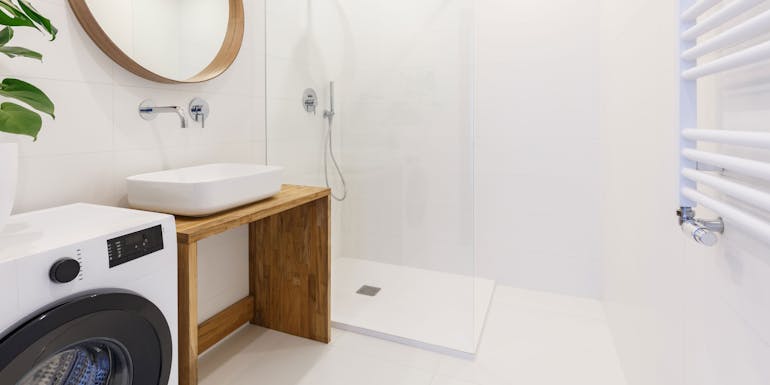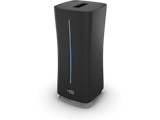
Nadine Walder, 9 December 2022
Humidify the air
How much electricity does a humidifier use?
Many of us are worried about increasing heating and energy costs and are starting to think about our consumption. Have you ever wondered how much energy different appliances use? In this article, we will explain how much electricity various humidifiers use compared with common domestic appliances. Modern energy-efficient humidifiers – like many other appliances – are designed for low energy consumption. What’s more, a humidifier can even help you cut down on heating costs.
How much electricity does a humidifier use?
Lots of different humidifier systems are available. Therefore, it’s hard to say exactly how much electricity a humidifier uses, as every system is different.
Vaporisers heat water to humidify a room, which is then released into the atmosphere as steam. They are highly effective humidification appliances, but they also use the most electricity. Our vaporiser Fred uses between 3.6 to 7.2 kWh of energy per 24 hours, depending on the power level. Vaporisers are particularly suited to humidification of larger rooms. The big advantage of vaporisers is that heating the water kills any germs and bacteria effectively. It is important to remember that the humidity level needs close monitoring with these appliances. This can be done manually by using a hygrometer and then switching the humidifier on and off yourself, or with an integrated or external Hygrostat. Leaving the humidity level unmonitored can lead to excessive humidification and unnecessary energy consumption.
Mist humidifiers with an integrated hygrostat use ultrasound to turn water into a mist which is released into the room. These appliances are very efficient. They don’t use much electricity compared with vaporisers. Our ultrasonic mist humidifiers use between 0.24 and 2.28 kWh of energy per 24 hours. Without a hygrostat, however, mist humidifiers can cause excessive humidification, because they are very effective. If the appliance does not automatically switch off once the optimal humidity level is reached, energy will be wasted. The benefit of mist humidifiers with an integrated hygrostat is that they measure the humidity level and automatically switch off when the desired humidity level is reached.
Evaporative humidifiers utilise the natural process of evaporation. Dry air is sucked in, humidified inside the appliance, then released back into the room. Excessive humidification isn’t possible with this system. Evaporative humidifiers are very energy-efficient and use little electricity. They are more energy-efficient and sustainable, but they take slightly longer to humidify a room. Our evaporative humidifiers only use between 0.14 and 0.72 kWh of energy per 24 hours.
It’s important to consider more than just the energy consumption when choosing a suitable humidifier. Factors such as which rooms need humidifying, how big the rooms are and how sustainable the humidification needs to be are also important. If these things aren’t considered, the humidifier risks being inefficient to use, resulting in a suboptimal ratio between performance and energy consumption.
How much electricity does a humidifier use compared with other appliances?
Showering, using the washing machine and doing the washing-up use the most energy in a typical Swiss household after heating. A three-minute hot shower uses about 1 kWh of energy. A 60-degree laundry wash uses between 1 and 1.6 kWh (1). By way of comparison: our humidifier Karl uses about the same amount of energy in one month in continuous use on the lowest power setting. Baking three pizzas every month for a year or leaving Karl on the lowest setting for a year would use the same amount of energy.
Other illustrative examples include: playing on the Playstation PS5 for one hour or using our humidifier Karl big on maximum power for five hours uses the same amount of energy. Or: our humidifier Oskar uses about the same amount of electricity in continuous use as a 10-watt energy saving bulb. Humidifier and aroma diffuser Ben uses about the same amount of energy in four months of continuous use as a PC or monitor on standby does in a year (1).
Note with these comparisons that a humidifier is rarely on continuously for the whole year. Humidifiers are usually only used in the colder months when humidity levels fall. Taking that into account, the annual consumption of humidifiers is low compared with other appliances. You can also take advantage of humidifiers to reduce heating costs.
Cut down on heating costs with a humidifier
It might surprise you, but a humidifier can help you cut down on heating costs. This is mainly because of the relationship between relative humidity and the perceived temperature. The perceived temperature is the temperature that humans feel, which can differ from the actual measured temperature due to various factors. Air humidity is one influential factor in this. For example, a room temperature of 20 degrees feels like 20 degrees at 40% humidity. At 50% humidity, the temperature feels more like 22 degrees (2).
Therefore, if you have the ideal humidity level in your room, you can turn down the heating and save money. You won’t feel the difference because humidity increases the perceived temperature. A humidifier gives you the perfect combination: energy-efficient consumption and a useful appliance to reduce heating costs. Turning the room temperature dial down by one degree saves about 640 kWh of energy a year. That’s a saving of about 170 Swiss francs based on the latest energy price forecasts (November 2022).
If you have questions related to indoor room climate, please get in touch with us. Or subscribe to our newsletter to regularly get informed about current topics regarding indoor climate, experience reports or Stadler Form insights.
***
Sources:
(2) Martin, L. (2013, 19. Juli). “Humidex” anyone? Northcountry Public Radio.














